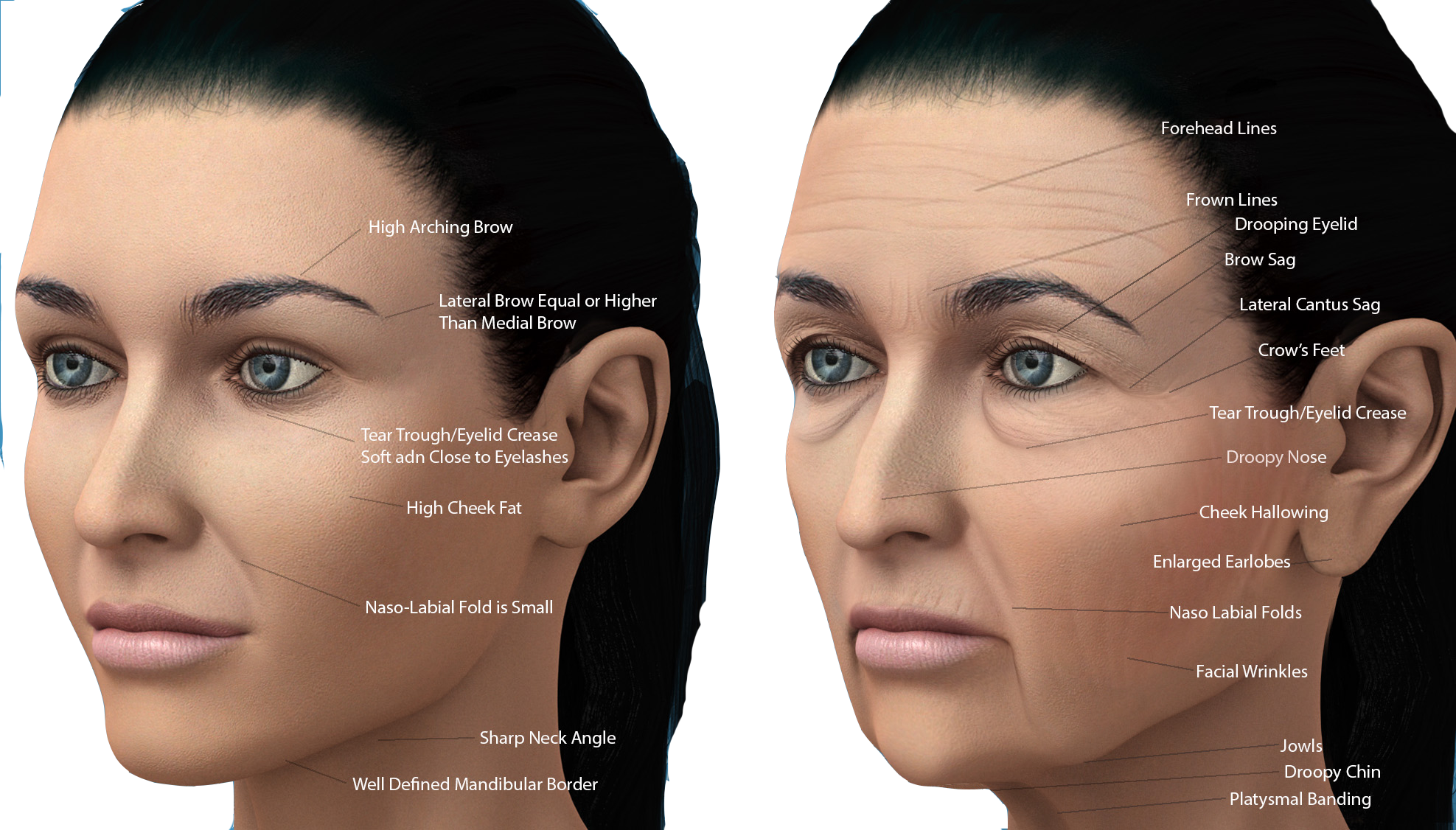
Facelift
Introduction
Signs of aging in the face and neck occur for many reasons, such as heredity, skin type, sun exposure, and lifestyle choices.
If you are bothered by a combination of deep facial wrinkles, sagging jowls, drooping eyelids, or loose skin and excess fatty deposits under your chin or on your neck, a facelift may be right for you.
A full facelift is best described as a combination of separate procedures that affect different areas of the face. Not all people need the same procedures, so what may be full facial rejuvenation for one person may involve a slightly different set of procedures for another.
Typically a full facelift involves a lower or mid facelift, a forehead lift and sometimes eyelid surgery.
Your plastic surgeon can help decide the best options to give you the results you desire. A general overview is presented here, and surgical details for individual procedures commonly performed during a full facelift can be viewed separately.
The Forehead
A forehead lift, also known as a brow lift, reduces forehead lines and creases, and can improve frown lines that may appear between your eyebrows. Sagging eyebrows may also be lifted with this procedure, restoring a firmer, more youthful appearance to the upper portion of your face.
Upper Eyelids and Lower Eyelids
Eyelid surgery, also known as blepharoplasty, may be performed on the upper eyelids, the lower eyelids, or both. During eyelid surgery, fatty deposits are removed or repositioned and excess skin and muscle tissues are often removed to brighten the appearance of the eyes.
The Mid Face
The mid facelift, sometimes referred to as a cheek lift, rejuvenates the center of the face in an area approximately from the corners of the eyes to the sides of the mouth. Underlying muscles and fat that have sagged over time are lifted back up onto the cheek bones.
The Lower Face and Neck
A lower facelift can help to reduce the appearance of deep facial wrinkles, sagging jowls, and sagging in the neck, restoring a firmer, more youthful appearance. During a lower facelift, underlying tissues and muscles are repositioned, fat deposits are removed, facial skin is tightened, and excess skin is removed.
For More Information
Consult with your physician to discuss the best options for you. You may learn more details about specific procedures in individual animations or by researching the particular procedures.
What are the risks of facelift surgery?
The decision to have plastic surgery is extremely personal and you will have to weigh the potential benefits in achieving your goals with the risks and potential complications of facelift surgery. Only you can make that decision for yourself.
You will be asked to sign consent forms to ensure that you fully understand the procedure and any risks and potential complications.
Facelift risks, while rare, include:
- Anesthesia risks
- Bleeding
- Deep vein thrombosis, cardiac and pulmonary complications
- Facial nerve injury with weakness
- Fluid accumulation
- Infection
- Numbness or other changes in skin sensation
- Persistent pain
- Poor wound healing and skin loss
- Prolonged swelling
- Skin irregularities and discoloration
- Sutures may spontaneously surface through the skin, become visible or produce irritation that require removal
- Temporary or permanent hair loss at the incisions
- Unfavorable scarring
- Unsatisfactory results may include asymmetry, unsatisfactory surgical scar location and unacceptable visible deformities at the ends of the incisions
These risks and others will be fully discussed prior to your consent. It is important that you address all your questions directly with your plastic surgeon.
What should I expect during my facelift recovery?
Following completion of a facelift, a bandage might be placed around your face to minimize swelling and bruising. Small tubes may be present to draw off any excess blood or fluid.
You will be given specific instructions on how to care for the surgical site and drains, medications to apply or take orally, specific concerns to look for at the surgical site or in your general health and when to follow up with your plastic surgeon.
Be sure to ask your plastic surgeon specific questions about what you can expect during your recovery period.
- Where will I be taken after my surgery is complete?
- What medication will I be given or prescribed after surgery?
- Will I have dressings/bandages after surgery?
- When will they be removed?
- When will the stitches be removed?
- When can I wash my face and wear make-up?
- When can I resume normal activity and exercise?
- When can I color my hair or get a haircut?

How much does a facelift cost?
The average cost of a facelift is $8,000 , This average cost is only part of the total price – it does not include anesthesia, operating room facilities or other related expenses. Please consult with your plastic surgeon’s office to determine your final fee.
A surgeon’s fee for facelift surgery will be based on his or her experience, the type of procedure used and the geographic office location.
Most health insurance plans do not cover facelift surgery or its complications, but many plastic surgeons offer patient financing plans, so be sure to ask.
Facelift costs may include:
- Surgeon’s fee
- Hospital or surgical facility costs
- Anesthesia fees
- Prescriptions for medication
- Post-surgery garments
- Medical tests
When choosing a board-certified plastic surgeon in your area for facelift surgery, remember that the surgeon’s experience and your comfort with him or her are just as important as the final cost of the surgery.
we can say the total cost maybe between $10,000 to $15,000
Breast:
- Breast Augmentation
- Breast Lift
- Breast Reduction
- Breast Implant Removal
- Nipple Correction
- Gynecomastia Surgery
Non Surgical Procedures:
About & Contact:
Gallery & Media:
